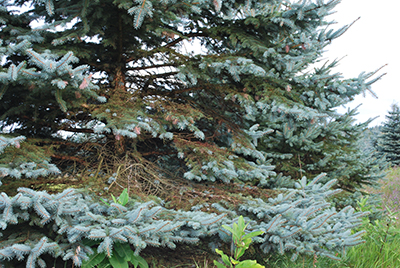Christmas tree, turf and ornamental plants update – April 21, 2017
Callery pears are showing up in the landscape, and white pine weevil adults are being caught in traps. Fishing spider activity is early this year.

The following is a summary of current plant development and pest activity for landscape professionals, Master Gardeners, nursery and Christmas tree growers.
Activity around the state
In southeastern Michigan, we are seeing numerous callery pears in landscapes as well as showing up as invasive volunteer trees along roadsides. As you plan your landscape plantings this spring, be mindful of plant selection. Michigan State University Extension recommends homeowners diversify their landscapes to help make them more resilient to pest and environmental changes. Homeowners should also plant a variety of species wherever possible.
White pine weevil (Pissodes strobi Peck) adults are being caught in traps in the Lower Peninsula. These over-wintering adults move from the litter underneath the tree to the treetops to mate and lay eggs. Usually, this begins between 7 and 58 growing degree-days base 50 (GDD50).
We often find white pine weevil damaging the leaders of Norway spruce, Serbian spruce, Colorado blue spruce, white pine and Scots pine. If you are considering treating for this pest, apply a registered pesticide to control the egglaying adults.
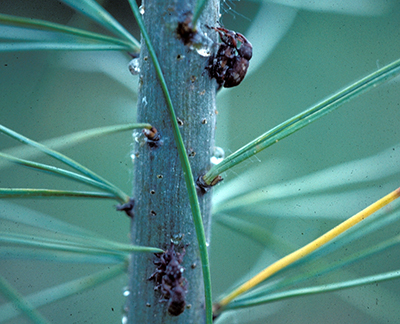
White pine weevil adults mating and laying eggs on leader of white pine. Image courtesy of Daniel Herms, Ohio State University, Bugwood.org.
Samples sent to MSU Diagnostic Services
MSU Diagnostic Services is receiving questions from homeowners about chemical control options for needlecast and canker pathogens of spruce. Large spruce in landscape settings are commonly subject to insect and pathogen problems. There is no easy fix for these issues. If you choose to use fungicides for treatment, you need to fully understand the challenges and limitations of possible fungicide treatments. For more information on spruce decline, read “What is spruce decline and what should you do about it?” by MSU Extension.
Declining spruce tree.
Samples with symptoms of crown gall and leafy gall have been submitted recently. Both are caused by bacterial pathogens and can be problematic in commercial production, particularly on vegetative propagated plant material. Please contact MSU Diagnostic Services for further information on diagnostic details of these diseases
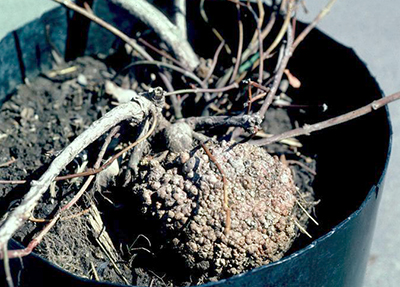
Crown gall (Rhizobium radiobacter). Image courtesy of Whitney Cranshaw, Colorado State University, Bugwood.org.
Fishing spiders are active early this year. This dark fishing spider, Dolomedes tenebrosus (Pisauridae) was photographed in Holt, Michigan, this past week. To read more about these handsome arachnids, see “Fishing spiders” by MSU Extension.
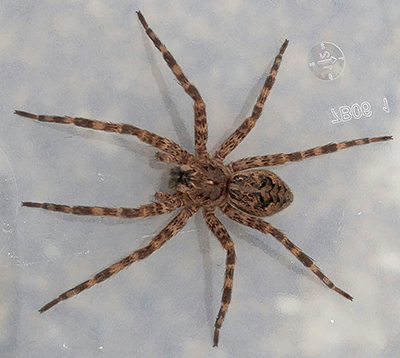
Fishing spider in Holt, Michigan. Image courtesy of Kylee Prater.
Overwintering boxelder bugs are still congregating on homes. Many people are experiencing large numbers of boxelder bugs on the outside of their homes, especially on the south and west facing walls.
Boxelder bugs invade homes during fall seeking protected sites in which to spend winter. Gaps around windows and doors and under siding are among their favorite spots. As the weather warms in spring, they move back to the exposed surfaces during the day to bask in the sun while they wait for nearby boxelder trees to flower. As the flowers begin to appear, they will migrate back to the trees where they will mate and lay their eggs.
They will soon go away on their own, so there is no need for drastic control measures at this time unless you are looking for revenge.
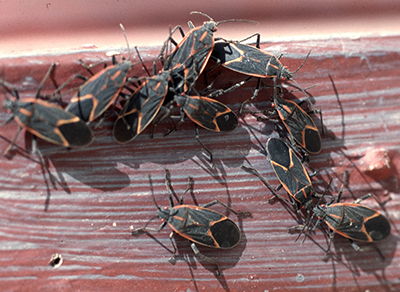
A cluster of Boxelder bugs. Image courtesy of Whitney Cranshaw, Colorado State University, Bugwood.org.
Finally, Julie Stachecki with Site Specific sent in this photograph of extreme red squirrel pruning of a Norway spruce.
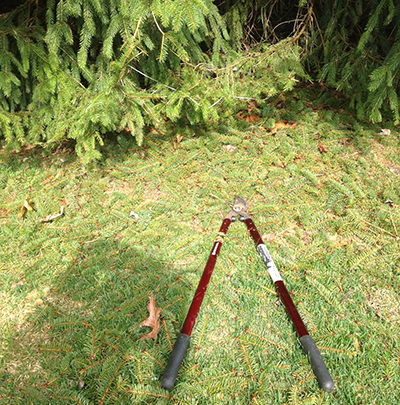
Red squirrel injury to Norway spruce. Image courtesy of Julie Stachecki.



 Print
Print Email
Email